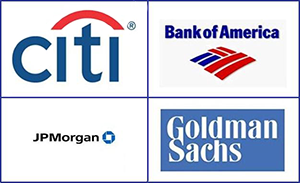By Pam Martens and Russ Martens: January 14, 2015
 JPMorgan Chase reported 2014 fourth quarter earnings this morning, missing analyst estimates. Analysts had expected $1.31 per share while the actual number came in at $1.19. Listening to the conference call this morning, there was the impression that the $1.19 would have been worse had the bank not released loan loss reserves in a number of business areas.
JPMorgan Chase reported 2014 fourth quarter earnings this morning, missing analyst estimates. Analysts had expected $1.31 per share while the actual number came in at $1.19. Listening to the conference call this morning, there was the impression that the $1.19 would have been worse had the bank not released loan loss reserves in a number of business areas.
Jamie Dimon, CEO of JPMorgan Chase, was back to characterizing the bank’s P&L as the “fortress balance sheet.” The London Whale credit derivatives traders almost blew up the fortress in 2012 and the markets are becoming skeptical as to just how much visibility there is on energy and emerging market loans souring on the books of the mega Wall Street banks.
In early December, Oppenheimer analyst Chris Kotowski noted in a report that plunging oil prices could be the greatest threat to the largest U.S. banks since the epic financial turmoil in 2008 while also warning that visibility into the banks’ loan exposure to the oil and exploration industry is limited.
That’s a very valid point. Another valid point is that visibility into the big banks’ exposure as counterparties to derivatives tied to plunging oil and commodity prices and shaky emerging market debt is also being kept under wraps – at least for now. The only clue as to which banks may take a hit, either from direct exposure or from loans to hedge funds taking a bath in the sectors, is the price action of the bank shares in the open market.
In a December 15 article by Patrick Jenkins in the Financial Times, readers learned that data from Barclays indicated that “energy bonds now make up nearly 16 per cent of the $1.3 trillion junk bond market — more than three times their proportion 10 years ago,” and “Nearly 45 per cent of this year’s non-investment grade syndicated loans have been in oil and gas.” Raising further alarms, AllianceBernstein has released research suggesting that the deals were not fully subscribed by investors with the potential that “as much as half of the outstanding financing from the past couple of years may be stuck on banks’ books.”
The Dow Jones Industrial Average is having its own perfect storm: two big oil plays, ExxonMobil and Chevron are in the Dow along with two big financial plays, JPMorgan Chase and Goldman Sachs. After fifteen minutes of trading this morning, the Dow was down more than 220 points with JPMorgan and Citigroup off by more than 3 percent.
Citigroup will issue its fourth quarter earnings report tomorrow at 8 a.m. but the market has already been prepped for a blood bath. At a Goldman Sachs conference on December 9, Citigroup’s CEO, Michael Corbat, preannounced that Citigroup would take $3.5 billion in charges for the fourth quarter, likely wiping out all but a sliver of earnings for the quarter. According to Corbat, $2.7 billion of that figure would be litigation related with another $800 million resulting from closing retail branches.
Fortunately for the market, Citigroup was kicked out of the Dow on June 8, 2009 after becoming a penny stock and replaced with The Travelers Companies. Citigroup’s current stock price in the high $40s paints a rosier picture than the reality of the situation: the company did a 1 for 10 reverse stock split in 2011, stripping 9 shares away from its shareholders for every 10 owned. Without that maneuver, its stock would have opened at $4.90 this morning rather than $48.96.
The opacity of the banks’ situation is creating a mindset on Wall Street to sell first and ask questions later. On days when oil is plunging in price, big bank stocks are getting hit across the board. Institutional investors with large bank positions who can’t readily dump shares are trying to hedge their exposure by buying puts on Exchange Traded Funds (ETFs) which track the financial services sector. Wholesale dumping of shares could come later if more negative news emerges.
Another serious problem for the big banks is the flattening of the yield curve – meaning the difference in yield between the 10-year and 30-year U.S. Treasury is contracting. As of this morning, the difference in yield was a mere 61 basis points with the 10-year trading at a yield of 1.82 percent and the 30-year at a yield of 2.43 percent. The compression in yield squeezes the banks’ profits since they are unable to borrow short and lend at a much higher rate at the long end.

